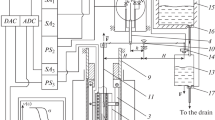Abstract
Materials that develop large strokes under precise and rapid control exhibit a great potential in mechanical engineering. Actuators made from those kinds of materials could replace hydraulic, pneumatic, and electromagnetic drives in many applications. However, no such materials are available to date. Piezoelectric and magnetostrictive materials exhibit rapid response, but their strokes are small. In shape memory alloys, strokes are large, but their control is slow due to thermomechanical control. Magnetic control of the shape memory effect was recently suggested by the present author for a principle of new kinds of actuator materials. These materials can develop strains of several percent, and their control is rapid and precise. Actuation of these materials is based on the reorienting of the twin structure of martensite or the motion of austenite-martensite interfaces by applied magnetic field. In the present report, magnetically induced motion of the austenite-martensite interfaces is demonstrated in an Fe-33.5Ni alloy.
Similar content being viewed by others
References
M.V. Gandhi and B.S. Thompson,Smart Materials and Structures, Chapman & Hall, 1992, p 1–309
A.E. Clark, High-Power Magnetostrictive Transducer Materials,Proc. of the 3rd International Conference on New Actuators, 24– 26 June 1992 (Bremen, Germany), H. Borgmann and K. Lenz, Ed., VDl/VDE-TechnologiezentrumInformationstechnik Gmbh, 1992, p 127–132
T.W. Duerig, K..N. Melton, D. Stöcker, and CM Wayman,Engineering Aspects of Shape Memory Alloys, Butterworth-Heinemann Ltd., 1990
K. Ullakko, P.T. Jakovenko, and V.G. Gavriljuk, High-Strength Shape Memory Steels Alloyed with Nitrogen,Scr. Metall. Mater., Vol. 34,1996, 6 p
K. Ullakko, Magnetic Control of Shape Memory Effect,International Conference on Martensitic Transformations ICOMAT-95, 20–25 August 1995 (Lausanne, Switzerland) Ecole Polytechnique Federale de Lausanne (Abstract)
K. Ullakko, “Large-Stroke and High-Strength Actuator Materials for Adaptive Structures,”Proc. of 3rd International Conference on Intelligent Materials and 3rd European Conference on Smart Structures and Materials, to be held 3–5 June 1996 (Lyon, France), INSA de Lyon, France and University of Stratchlyde, UK, 6 p
K. Ullakko, P.T. Jakovenko, and V.G. Gavriljuk, “New Developments in Actuator Materials as Reflected in Magnetically Controlled Shape Memory Alloys and High-Strength Shape Memory Steels,”Proc. of Symposium on Smart Structures and Materials, 26–29 Feb 1996 (San Diego, CA), International Society for Optical Engineering, 9 p
K. Ullakko, P.T. Jakovenko, and V.G. Gavriljuk, “New Developments in Actuator Materials as Reflected in Magnetically Controlled Shape Memory Alloys and High-Strength Shape Memory Steels,” submitted toSmart Materials and Structures, Institute of Physics Publishing and the International Society for Optical Engineering, 1996,9 p
R.M. Bozorth,Ferromagnetism, The Institute of Electrical and Electronics Engineers, Inc., 1993, p 1–959
V.V. Martynov and V.V. Kokorin, The Crystal Structure of Thermally and Stress-Induced Martensites in Ni2MnGa Single Crystals,J. Phys. Ill (France), Vol 2, 1992, p 739–747
J.M. Howe,In situ High-Resolution Transmission Electron Microscope Study of Martensite Nucleation and Growth in a Co-32Ni Alloy,Proc. of the International Conference on The Martensitic Transformations ICOMAT-92, CM. Wayman and J. Perpins, Ed., Monterey Institue of Advanced Studies, 1992, p 185–190
K. Ullakko, “Aging of Iron-Based Martensites at Low Temperatures,” Report No. 3/1992/MTR, Helsinki University of Technology, ISBN 951-22-1101-7, 1992, p 1-137
K. Ullakko and V.G. Gavriljuk, Effects of Coherent Interfaces in the Freshly Formed Iron-Nickel-Carbon Martensites,Acta Metall. Mater., Overview NO. 99, Vol 40, 1992, p 2471–2482
V.D. Sadovsky, Peculiarities of Martensitic Transformations Induced by Magnetic Field,Proc. of The Int. Conf. on Martensitic Transformations ICOMAT-86, The Japan Institute of Metals, 1996, p 222-229
K. Shimizu, N. Yamao, T. Kakeshita, M. Ono, K. Sugiyama, and M. Date, Magnetic Field-Induced Martensitic Transformation in an Fe-Ni-Co Alloy,Mater. Sci. Forum, Vol 56-58, 1990, p 235–240
T. Kakeshita, K. Shimizu, T. Maki, I. Tamura, S. Kijima, and M. Date, Magnetoelastic Martensitic Transformation in an Ausaged Fe-Ni-Co-Ti Alloy,Scr. Metall., Vol 19, 1985, p 973–976
T. Maki and C.M. Wayman, Transformation Twin Width Variation in Fe-Ni and Fe-Ni-C Martensites,Proc. of the 1st JIM International Symposium on New Aspects if Martensitic Transformation, Suppl. to Trans. JIM, Vol 17, 1976, p 69–74
Author information
Authors and Affiliations
Additional information
On leave from TECHNOBOTHNIA Research Center, 65101 Vaasa, Finland
Rights and permissions
About this article
Cite this article
Ullakko, K. Magnetically controlled shape memory alloys: A new class of actuator materials. JMEP 5, 405–409 (1996). https://doi.org/10.1007/BF02649344
Issue Date:
DOI: https://doi.org/10.1007/BF02649344




